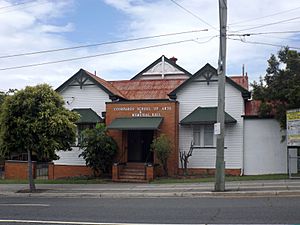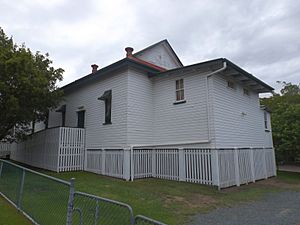Coorparoo School of Arts and RSL Memorial Hall facts for kids
Quick facts for kids Coorparoo School of Arts and RSL Memorial Hall |
|
|---|---|

View from Cavendish Road, 2015
|
|
| Location | 208 Cavendish Road, Coorparoo, City of Brisbane, Queensland, Australia |
| Design period | 1870s – 1890s (late 19th century) |
| Built | 1892–1953 |
| Built for | Coorparoo Shire Council |
| Official name: Coorparoo School of Arts and RSL Memorial Hall, Coorparoo School of Arts, Coorparoo Shire Hall | |
| Type | state heritage (built) |
| Designated | 6 January 1999 |
| Reference no. | 602054 |
| Significant period | 1892–1925 (historical council) 1920s (historical school of arts) 1890s–1950s (fabric) 1890s ongoi |
| Significant components | memorial – honour board/ roll of honour, hall, objects (movable) – communications |
| Lua error in Module:Location_map at line 420: attempt to index field 'wikibase' (a nil value). | |
The Coorparoo School of Arts and RSL Memorial Hall is a special building in Coorparoo, Australia. It's listed on the Queensland Heritage Register because of its history and importance. This building has been around since 1892 and has served many purposes. It was once a local government office, then a place for learning and community events. Today, it's also a memorial hall, remembering those who served in wars.
A Look Back: The Hall's History
The Coorparoo School of Arts and RSL Memorial Hall was first built in 1892. It was made for the Coorparoo Shire Council, which was like the local government for the Coorparoo area back then. The Council used the building until October 1925.
How Coorparoo Got Its Own Council
Before 1888, Coorparoo was part of a larger area managed by the Bulimba Divisional Board. This board looked after things like roads, bridges, and water supply. Some local leaders and residents felt that Coorparoo needed its own council to get more things done. They worked hard to make this happen. On 27 October 1888, the Shire of Coorparoo was officially created.
Building the Shire Hall
By 1892, the new Coorparoo Council decided they needed their own main building, a "Shire Hall." They bought some land on the corner of Cavendish Road and Council Street (now Halstead Street). A local architect named Henry Wallace Atkinson designed the hall. It cost about 514 pounds to build, which was a lot of money back then! The Council moved into their new hall on 7 October 1892.
Modern Features for Its Time
This new hall was quite modern for its time. It was the very first building in the Coorparoo area to have gas lighting. Imagine, no more candles or oil lamps! Also, the first telephone in the district was installed here on 1 November 1892. This shows how important the hall was to the community.
The hall quickly became a popular place for social events. People would gather there for meetings, dances, and other community activities.
Remembering Those Who Served
On 24 June 1916, a special "Roll of Honour" was put up in the hall. This board lists the names of men and women from the Coorparoo area who served in World War I. It's a way to remember their bravery and sacrifice.
Becoming a School of Arts
In 1925, many local governments in the Brisbane area joined together to form Greater Brisbane. This meant the Coorparoo Shire Council no longer needed its own hall. Local residents decided to turn the building into a "School of Arts."
A School of Arts was a community centre where people could learn new skills, read books, and attend lectures. It was a place for education and culture. In 1928, the group managing the School of Arts agreed to buy the hall from the Greater Brisbane City Council.
Changes and Additions
Over the years, the hall saw some changes. In 1930, a side verandah was added, giving the building more space. Later, in 1938, the stage inside the main hall was moved to the back, creating more room for events.
The RSL Joins In
By the 1940s, the School of Arts faced some financial challenges. In 1946, the Brisbane City Council asked for the remaining payment for the hall. Around this time, the Coorparoo R.S.L. (a group for ex-service people) suggested they help.
In 1956, the School of Arts and the R.S.L. officially joined forces. The hall was then renamed the Coorparoo School of Arts and RSL Memorial Hall. This new name reflected its dual purpose: a place for community learning and a memorial for those who served.
In the early 1950s, more additions were made to the front of the hall. These brick and stucco sections were designed by architect Eric Percival Trewern. The hall continues to be used by the community today.
What the Hall Looks Like
The Coorparoo School of Arts and RSL Memorial Hall is a single-storey building made of timber. It has a corrugated iron roof and sits on concrete stumps. You can find it on the corner of Cavendish Road and Halstead Street in Coorparoo.
Outside the Building
The original design of the hall from 1892 is still clear. The main hall is at the back, and smaller rooms are at the front. Over the years, parts have been added, like the verandah in the 1930s and the brick section at the front in the 1950s.
The front of the building, facing Cavendish Road, has two parts that stick out. There are windows with decorative timber covers. The brick section added in the 1950s is in the middle. On this brick part, you can read the name: "Coorparoo School of Arts & R.S.L. Memorial Hall."
Inside the Building
When you go inside, you enter a front area with two rooms on either side. A special strong room, used for keeping important things safe, can be accessed from one of these rooms.
Double timber doors lead into a small hallway. These doors have a unique angled timber design. The building's old street numbers, 208 and 210, are still visible on small metal plates. There are also toilets, which were added in the 1950s, with shiny terrazzo floors.
More timber doors lead into the main hall. This large room has a timber floor and a raised stage at one end. The ceiling has decorative timber vents. The main hall is a big, open space used for many community events.
Special Features Inside
Inside the main hall, you'll find two very interesting items:
- The Coorparoo Roll of Honour: This is a copper board on a timber base. It has the names of service members on individual brass strips. The board is decorated with scrolls, flowers, and cannons.
- The First Telephone: The very first telephone in the district is still here! It's a wooden phone inside a timber box with a glass front.
The building also has a verandah on one side, which includes kitchen facilities. Outside, the property has a low wire fence and a car park at the back.
Why It's a Heritage-Listed Site
The Coorparoo School of Arts and RSL Memorial Hall was added to the Queensland Heritage Register on 6 January 1999. This means it's considered a very important historical place in Queensland. Here's why:
- Shows Queensland's History: The hall helps us understand how local government developed in Coorparoo. It also shows how important community buildings were in the past. It was the first building in the area with gas lights and the first to have a telephone!
- A Great Example of Its Kind: The hall is a good example of what a local shire hall looked like in the late 1800s. It still looks much like it did when it was first built.
- Looks Good in the Area: The building adds to the beauty and character of the streetscape where it's located, at the corner of Cavendish Road and Halstead Street.
- Important to the Community: This hall has a very strong connection with the people of Coorparoo. It has been a central place for social events and community gatherings for a long time, and it still is today.
- Connected to Important People: The hall is also significant because it was designed by a notable architect of the time, Henry Wallace Atkinson, in 1892.


